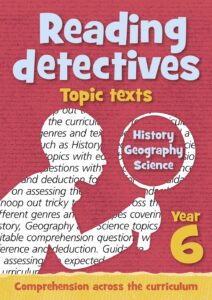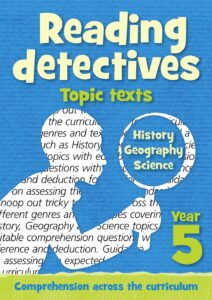We asked Reading Detectives author and all-round Primary reading expert, Rachel Clarke, to give us her thoughts on this year’s KS2 reading paper and what it might mean for your teaching next year.
The Texts
This year’s KS2 reading SAT contained an information text: The Giant Panda Bear; a poem: Grannie; and a fictional extract: Albion’s Dream. As a specially commissioned piece, The Giant Panda Bear contained several features we would expect in information writing aimed at children including: clearly signposted sections, supportive illustrations and graphic design features relevant to the content matter. Certainly the text included frequent reference to numerical facts, which may have been distracting for some pupils, e.g. ‘An adult can grow up to 1.5 metres and weigh up to 150 kilograms,’ and ‘Cubs stay with their mother for two to three years, reach maturity at five to seven years and live in the wild for about 25 years.’ And there were also some interesting vocabulary choices that may not have been fully recognised by all readers, e.g. ‘razor-like claws’, ‘densely populated’, ‘bamboo supplies are diminishing’. But on the whole, this first text appeared reasonably accessible.

If I were a betting woman, I’d have had money on the inclusion of a poem in this year’s test. Alas I’m not, but I do maintain a certain degree of smugness having reminded my teaching network to include poetry in their pre-SAT preparations. Grannie by Vernon Scannell presented as an accessible poem and was sourced from the excellent The Works 4, edited by Pie Corbett and Gaby Morgan. That the STA are sourcing test materials from such high-quality publications gives me hope for future tests. It also suggests that well-curated high-quality published resources should be informing our day-to-day English teaching.
The final text was an extract from Albion’s Dream a mystery story set in rural England during the post-war period. The extract describes the moment 12-year-old Jack discovers a mysterious board game in an old farmhouse. It’s a compelling piece, and I for one am desperate to find out what happens when Jack inevitably begins playing the game; sadly, the book is currently out of print. Albion’s Dream makes for a reasonably complex read; it was after all the third text, so we should expect a degree of challenge. The opening paragraph is a syntactically challenging combination of multiple clauses separated by semi-colons. As is so often the case with rich text, it is also dripping with idiomatic and inferential phrases such as ‘left to my own devices’ and ‘it dawned on me’. Understanding of these phrases was tested and I’ll return to them later.
Range of Marks and Content Domain Coverage
Of the 50 marks available 32 were 1 mark responses, 6 were 2 mark responses and 2 were 3 mark responses. These included the full range of find and copy, tick response, order the answers, and short and longer written responses.
The Reading Content Domain coverage in the 2018 KS2 SAT was as follows:
2a 10 marks (20%)
2b 13 marks (26%)
2c 3 marks (6%)
2d 22 marks (44%)
2e 0 marks (0%)
2f 0 marks (0%)
2g 0 marks (0%)
2h 2 marks (4%)
For the third year running, inferring information from the text (2d) was the most tested aspect of the Reading Content Domain. There were two 2d marks available for The Giant Panda Bear, nine for Grannie and eleven for Albion’s Dream. Just like last year, the majority of these 2d marks came from the third text. And unsurprisingly, the least 2d questions were asked of the non-fiction text. Retrieving information (2b) was the second most tested aspect of the Reading Content Domain with nine marks available for The Giant Panda Bear, three marks for Grannie and one mark for Albion’s Dream. Vocabulary has now contributed to 20% of the available marks in the KS2 reading SAT for the past three years. The marks were fairly evenly distributed across the three texts with three for The Giant Panda, four for Grannie and three for Albion’s Dream.
The significance of these three aspects of the Reading Content Domain in the national tests is a pertinent to all of us in our preparations for future tests. Pupils need a good knowledge of vocabulary, should be able to retrieve information and be able to infer meaning from what they have read.
Question Language

Whilst the texts themselves appeared reasonably accessible, many teachers have expressed surprise at the linguistic complexity of the questions themselves. In the first instance there was a continuation of a pattern from previous years where the wording of the question contained different language (whether synonyms or conceptual links) to the target word or phrase used in the text. For example, Question 2 asked: According to some scientists, how does giant panda’s fur help them to survive in the wild? The target information in the text was: They have thick black and white fur, which some scientists think may be to disguise them in the snowy and rocky surroundings where they live. This was a retrieval question (2b) in which pupils needed to connect the concepts of survival and camouflage. This certainly does seem quite tricky, especially considering it was question 2 and the first text. Clearly, we can’t predict the content of the questions and so prepare pupils by providing them with synonyms or contextual links. What we can do though is to ensure that the questions we frame mirror the structure of those in the test so that children build experience in answering this style of question.
Some further interesting linguistic patterns in the questions emerge upon further scrutiny. This year, six questions used the stem ‘according the text…’. In the case of five of these, they were retrieval (2b) questions, whilst the remaining question asked pupils to make comparisons within the text (2h). This is a particularly useful prompt to explore with pupils. On the one hand it is a signpost telling them to retrieve information from the text (even in the case of the 2h question they needed to find relevant information to make their comparisons), and on the other hand it is a reminder to refer to the text and not what they think they know based on their prior knowledge of the topic.
Another pattern apparent in the language of the questions centred on the ability to visualise based on the information given. Visualisation sits firmly within 2d (inference) and was tested twice through the use of the phrase ‘what impression/s’ and once through the use of the phrase ‘what suggests’. These are phrases that most Year 6 pupils are unlikely to use in their everyday language. Again, to build familiarity and understanding of what they are being asked to do, these phrases need to be used regularly in the classroom when asking 2d questions (and also with 2g questions of which there were none this year).
Vocabulary
1 in every 5 marks available were vocabulary questions (2a). These appeared in a number of formats including: ‘tick one answer’, ‘find and copy one word’, and ‘find and copy a group of words…’. That the meaning of a group of words is assessed as part of 2a, can be challenging. Particularly when it’s phrases such as ‘left to my own devices’ and ‘dawned on me’ that are not easily inferred from the context of the sentence or wider text. What this shows is that our vocabulary teaching needs to extend beyond the definition of single words and into understanding the phrases and idioms that pepper the English language.
Preparing for the SATs with Reading Detectives


Creating your own resources to build confidence and expertise in reading comprehension can be time consuming. As this analysis of the 2018 KS2 Reading SAT shows, children need access to rich, challenging text; they need to experience a range of question formats that use the language of the tests; and they need exposure to words and phrases beyond those they experience in their everyday lives. This is where Reading Detectives can help you out.
- The Reading Detectives books have been written with the KS2 SATs in mind.
- A wide range of texts including fiction, non-fiction and poetry are included in each book.
- Texts are rich and challenging so that children are accustomed to reading at the level of the SATs.
- Teaching inference skills is at the core of each Reading Detectives unit.
- Questions are framed using the language of the tests so there are plenty of ‘what impression’ and ‘what suggests’ style questions.
- Vocabulary questions are included in every unit, with many of these focusing on phrases as well as the meaning of single words.
- Many questions use synonyms or contextual knowledge rather than the target language.
- Detailed teaching notes are included to help teachers explain the answers rather than simply locating them in the text.
Find out more
Rachel Clarke is a freelance Primary English adviser and writer. She is series editor and author of the Reading Detectives. Find out more about Rachel at www.primaryenglished.co.uk .



